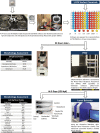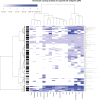Multidimensional in vivo hazard assessment using zebrafish
- PMID: 24136191
- PMCID: PMC3871932
- DOI: 10.1093/toxsci/kft235
Multidimensional in vivo hazard assessment using zebrafish
Abstract
There are tens of thousands of man-made chemicals in the environment; the inherent safety of most of these chemicals is not known. Relevant biological platforms and new computational tools are needed to prioritize testing of chemicals with limited human health hazard information. We describe an experimental design for high-throughput characterization of multidimensional in vivo effects with the power to evaluate trends relating to commonly cited chemical predictors. We evaluated all 1060 unique U.S. EPA ToxCast phase 1 and 2 compounds using the embryonic zebrafish and found that 487 induced significant adverse biological responses. The utilization of 18 simultaneously measured endpoints means that the entire system serves as a robust biological sensor for chemical hazard. The experimental design enabled us to describe global patterns of variation across tested compounds, evaluate the concordance of the available in vitro and in vivo phase 1 data with this study, highlight specific mechanisms/value-added/novel biology related to notochord development, and demonstrate that the developmental zebrafish detects adverse responses that would be missed by less comprehensive testing strategies.
Keywords: Tox21; ToxCast.; developmental; high-throughput screening.
Figures







Similar articles
-
A Comparison of ToxCast Test Results with In Vivo and Other In Vitro Endpoints for Neuro, Endocrine, and Developmental Toxicities: A Case Study Using Endosulfan and Methidathion.Birth Defects Res B Dev Reprod Toxicol. 2015 Apr;104(2):71-89. doi: 10.1002/bdrb.21140. Epub 2015 May 27. Birth Defects Res B Dev Reprod Toxicol. 2015. PMID: 26017137
-
Developmental Effects of the ToxCast™ Phase I and Phase II Chemicals in Caenorhabditis elegans and Corresponding Responses in Zebrafish, Rats, and Rabbits.Environ Health Perspect. 2016 May;124(5):586-93. doi: 10.1289/ehp.1409645. Epub 2015 Oct 23. Environ Health Perspect. 2016. PMID: 26496690 Free PMC article.
-
Screening for angiogenic inhibitors in zebrafish to evaluate a predictive model for developmental vascular toxicity.Reprod Toxicol. 2017 Jun;70:70-81. doi: 10.1016/j.reprotox.2016.12.004. Epub 2016 Dec 19. Reprod Toxicol. 2017. PMID: 28007540 Free PMC article.
-
Zebrafish: as an integrative model for twenty-first century toxicity testing.Birth Defects Res C Embryo Today. 2011 Sep;93(3):256-67. doi: 10.1002/bdrc.20214. Birth Defects Res C Embryo Today. 2011. PMID: 21932434 Review.
-
Developmental toxicity testing for safety assessment: new approaches and technologies.Birth Defects Res B Dev Reprod Toxicol. 2011 Oct;92(5):413-20. doi: 10.1002/bdrb.20315. Epub 2011 Jul 18. Birth Defects Res B Dev Reprod Toxicol. 2011. PMID: 21770025 Review.
Cited by
-
Comparative hazard analysis and toxicological modeling of diverse nanomaterials using the embryonic zebrafish (EZ) metric of toxicity.J Nanopart Res. 2015;17(6):250. doi: 10.1007/s11051-015-3051-0. Epub 2015 Jun 4. J Nanopart Res. 2015. PMID: 26069453 Free PMC article.
-
Leveraging Multiple Data Streams for Prioritization of Mixtures for Hazard Characterization.Toxics. 2022 Oct 29;10(11):651. doi: 10.3390/toxics10110651. Toxics. 2022. PMID: 36355943 Free PMC article.
-
Induced Pluripotent Stem Cell Models to Enable In Vitro Models for Screening in the Central Nervous System.Stem Cells Dev. 2015 Aug 15;24(16):1852-64. doi: 10.1089/scd.2014.0531. Epub 2015 Apr 20. Stem Cells Dev. 2015. PMID: 25794298 Free PMC article. Review.
-
Cryptolepine, the Main Alkaloid of the Antimalarial Cryptolepis sanguinolenta (Lindl.) Schlechter, Induces Malformations in Zebrafish Embryos.Biochem Res Int. 2019 Jul 8;2019:7076986. doi: 10.1155/2019/7076986. eCollection 2019. Biochem Res Int. 2019. PMID: 31360547 Free PMC article.
-
Evaluation of Developmental Toxicity, Developmental Neurotoxicity, and Tissue Dose in Zebrafish Exposed to GenX and Other PFAS.Environ Health Perspect. 2020 Apr;128(4):47005. doi: 10.1289/EHP5843. Epub 2020 Apr 9. Environ Health Perspect. 2020. PMID: 32271623 Free PMC article.
References
-
- Bretaud S., Lee S., Guo S. (2004). Sensitivity of zebrafish to environmental toxins implicated in Parkinson’s disease. Neurotoxicol. Teratol. 26, 857–864.10.1016/j.ntt.2004.06.014 - PubMed
-
- Cohen J. (1960). A coefficient of agreement for nominal scales. Educ. Psychol. Meas. 20, 37–46.10.1177/001316446002000104
-
- Cowden J., Padnos B., Hunter D., MacPhail R., Jensen K., Padilla S. (2012). Developmental exposure to valproate and ethanol alters locomotor activity and retino-tectal projection area in zebrafish embryos. Reprod. Toxicol. 33, 165–173.10.1016/j.reprotox.2011.11.111 - PubMed
-
- D’Amico L. J., Li C. Q., Seng W. L., McGrath P. (2008). Developmental neurotoxicity assessment in zebrafish: A survey of 200 environmental toxicants. In Society of Toxicology; March 2008; Seattle, WA.
Publication types
MeSH terms
Substances
Grants and funding
LinkOut - more resources
Full Text Sources
Other Literature Sources
Research Materials

